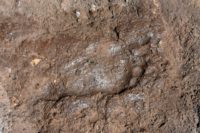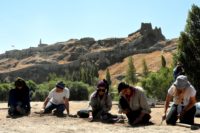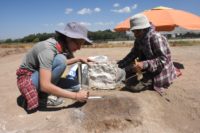 Archaeologists have discovered a human footprint left 3,000 years ago at the ancient fortress of Van Castle in southeastern Turkey. The print of a right foot is just over 10 inches long, the equivalent of a modern-day men’s size 9 (US) or 42 (European), and belonged to a young man of the Iron Age Urartu civilization which dominated this region of Anatolia from the 9th through the 7th century B.C. This is the first time since excavations began in 2015 that a print directly linked to an Urartu individual has been found at the site.
Archaeologists have discovered a human footprint left 3,000 years ago at the ancient fortress of Van Castle in southeastern Turkey. The print of a right foot is just over 10 inches long, the equivalent of a modern-day men’s size 9 (US) or 42 (European), and belonged to a young man of the Iron Age Urartu civilization which dominated this region of Anatolia from the 9th through the 7th century B.C. This is the first time since excavations began in 2015 that a print directly linked to an Urartu individual has been found at the site.
 Van Castle was built in the 8th and 7th centuries B.C., the heyday of the Urartian kingdom, also known as the Kingdom of Van. The clifftop fortress overlooked the capital city of Tushpa but it was not a defensive installation. Rather it was an instrument of regional control, one of multiple such citadels built in Urartu territory. Van is the largest of them all.
Van Castle was built in the 8th and 7th centuries B.C., the heyday of the Urartian kingdom, also known as the Kingdom of Van. The clifftop fortress overlooked the capital city of Tushpa but it was not a defensive installation. Rather it was an instrument of regional control, one of multiple such citadels built in Urartu territory. Van is the largest of them all.
 The citadel was constructed of a basalt stone foundation with mud brick walls, and the houses within its walls and in Tushpa were also made of mud brick. Archaeologists believe the footprint was left in wet mudbrick during the construction of one of those homes, likely by a male between 13 and 15 years of age.
The citadel was constructed of a basalt stone foundation with mud brick walls, and the houses within its walls and in Tushpa were also made of mud brick. Archaeologists believe the footprint was left in wet mudbrick during the construction of one of those homes, likely by a male between 13 and 15 years of age.
A plaster cast of the footprint was taken in situ to ensure the long-term protection and preservation of the print. The original print was raised for further examination in laboratory conditions. Anthropologists will study the structure of the foot in detail. Once the research is completed, the print and cast will be delivered to the Van museum.
